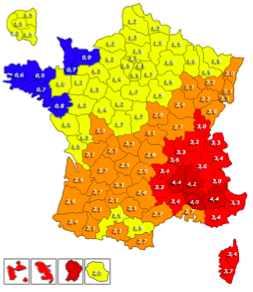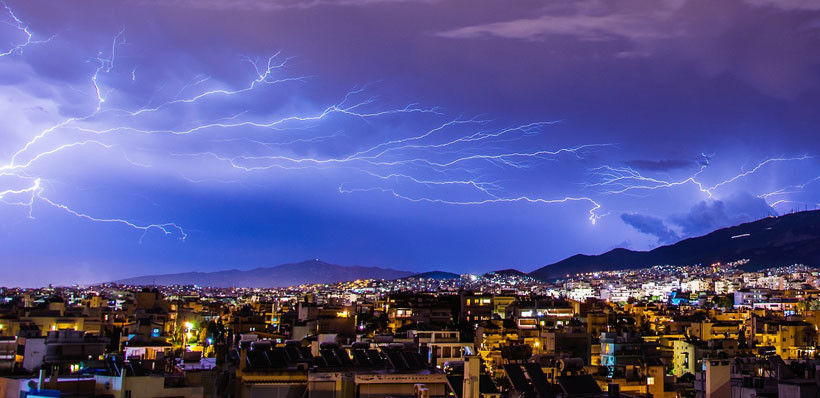How LEDs cope with overvoltage
Download the PDFOvervoltage poses a direct threat to the integrity and longevity of outdoor LED lighting. LEC has the solution.
All lighting systems with electronic components are vulnerable to overvoltage, especially LED luminaires. The use of adequate protection is thus vital to ensure their long-term durability.
Risks of overvoltage and safety recommendations for LED luminaires
LEC’s experts prioritise safety and longevity in their lighting systems, and thus follow the recommendations provided by the French Lighting Union’s joint statement, which precisely addresses the various causes of overvoltage for outdoor luminaires.
A - Transient overvoltage caused by lightning
There are two important factors to consider when protecting against lightning:
- The lightning density (measured in Ng), which is the number of lightning impacts per km2 and per year in an area
- The Keraunic level (measured in Nk), which is the number of days in a year when thunder can be heard

Risk of overvoltage across France, based on their Nk (Ng = Nk/10)
The NF-C-15-100 and the UTE C 15-443 risk guide set out regulations to minimise transient overvoltage and the risk of malfunction, including cascade protection with several types of surge arresters installed throughout the installation:
- Type 1 surge protector: effective against high-energy waves, at the top of the installation where there is a significant risk of a lightning strike e.g. when located close to a lightning rod.
- Type 2 surge protector: at the top of the installation, in parallel with the low-voltage main distribution panel, or near to vulnerable equipment.
- Type 2 or 3 surge protector: close to (a dozen metres) particularly vulnerable equipment or spread-out installations.
N.B: it is recommended to fit type 2 or 3 surge protectors at the base of pole floodlights. While these protectors may not be able to withstand as much overvoltage as type 1, their selectivity makes for good long-term protection.
Cascade protection is vital as it allows for:
- Surge protectors to be calibrated according to overvoltage waves: the most powerful receive the stronger waves first and filter them.
- Easy replacement of the protectors, which can withstand a specific amount and level of strikes.
- Overvoltage wave reamplification to be taken into account e.g. an overvoltage cut at 1.5 kV may reamplify itself at 3kV thirty metres down the line.
Here is the Citadel of Bonifacio illuminated with 78 of LEC's 4660-Corsica projectors. They are all equipped with surge protection cascaded in terms of position and features, using type 1, 2 and 3 equipment.

In July 2015, the Bonifacio Citadel was fitted with luminaires by LEC to provide its thousands of visitors with a spectacular night-time view.
B - Commutating overvoltage
This occurs when outdoor LED lighting installation is turned on as usual or when a neighbouring installation is switched on. It affects power equipment, LED modules and built-in control systems.
A 2 kV protection is recommended to ensure LED luminaires are fully safeguarded. The surge protectors used against lightning also provide decent protection against commutating overvoltage, as do type 2 and 3 protectors, which are perfectly appropriate to filter such overvoltage.
C - TOV (Temporary Over Voltage)
This occurs when a neutral conductor is disconnected within a three-phrase power supply.
To mitigate this risk, the electrical cabinet should be protected, and the networks should undergo regular maintenance.
LEC’s solutions to minimising the risk of overvoltage to outdoor lighting
Nowadays, the risk of overvoltage is constantly on the rise as the number of devices vulnerable to this problem multiplies, and networks become more polluted with the increased use of electronics. LEC works hard at every stage of the product lifestyle (design, manufacturing and installation) to ensure its outdoor LED luminaires are up to the job. This includes:
- Conducting several surge protector development tests in the labatory
- Educating fitters on the risks of overvoltage
- Allowing for overvoltages bigger than the local keraunic guidelines, to ensure proper operation in all conditions and all over the world
- The systematic protection using surge protectors, even in statistically low-risk areas as defined by the UTE –C 15-443
- The installation of 230 V floodlights certified for overvoltage levels of up to 10 kV, to guarantee complete resistance when line protections are limited in virtue of the distance to type 2 and 3 surge protectors fitted upstream (ground-recessed or scattered luminaires)
- Protection of 230 V inputs, as well as dimming inputs such as 0-10V, DMX, DALI, which can all encounter overvoltage
- The all-in-one solution of surge protectors fitted throughout the installation for reliable and easy-to-maintain cascade protection
All these measures are taken to guarantee that our products are durable and safe, satisfying the needs of city lighting master plans and light designers’ artistic projects
Do you have a LED outdoor lighting project in an overvoltage high-risk area? Ask for advice from a LEC expert.
-
Download the PDF
- Published on 30 March 2017
- Categories: Norms & Quality - Solutions by LEC
- Tags : LED luminaire - lightning - outdoor lighting - overvoltage - surge protector

